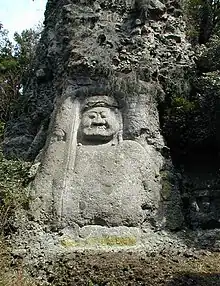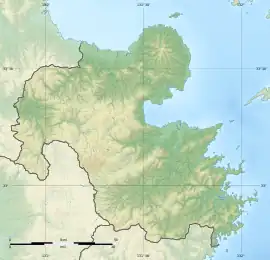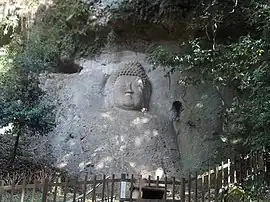熊野磨崖仏 | |
 Kumano Magaibutsu | |
 Kumano Magaibutsu  Kumano magaibutsu (Japan) | |
| Location | Bungotakada, Ōita Prefecture, Japan |
|---|---|
| Region | Kyushu |
| Coordinates | 33°28′41.1″N 131°31′32.3″E / 33.478083°N 131.525639°E |
| History | |
| Periods | Heian period |
| Site notes | |
| Public access | Yes |

The Kumano Magaibutsu (熊野磨崖仏) is a group of religious statues carved in bas-relief into a tuff cliff in the Hirano, Manaka, and Ueno neighborhoods of the city of Bungotakada, Ōita Prefecture on the island of Kyushu, Japan. The carvings were designated as a National Important Cultural Property in 1964[1] and collectively with the Motomiya magaibutsu (元宮磨崖仏) and Nabeyama magaibutsu (鍋山磨崖仏) were designated a National Historic Site of Japan in 1955, with the area under protection adjusted in 1996.[2]
Overview
Constructing Buddha statues out of stone is widely practiced in Buddhist areas in Asia. These images can be divided into three broad types: Magaibutsu (磨崖仏), bas-relief images carved directly into a cliff face, movable independent stone Buddhas carved from cut stone, and cave Buddhas carved inside rock caves, The Inukai images can be classed as Magaibutsu.
The Kumano Magaibutsu
The Kumano Magaibutsu consist of four images carved into the rock wall of the approach leading from Konkumanozan Taizo-ji, one of theTendai temples founded in the Nara period and associated with shugendō mountain cults which flourished during the Nara and Heian period in the Kunisaki Peninsula. Taizo-ji was the jingū-ji for the Kumano Shrine in the mountains of Hinatatira at the southern end of the Tashibu district. The central statue is a half-body statue with a height of approximately 6.8 meters, believed to be that of Dainichi Nyōrai. It is carved into the center of a niche approximately eight meters high. It is unknown when this statuewere carved, but stylistically it is estimated to have been created in the mid-Heian period. On the rock that juts out to the left when facing Dainichi Nyorai is a statue of Fudō Myōō, approximately eight meters high, and on the left and right below it are statues of Kongara Dōji and Seitaka Dōji, both approximately three meters high. These images are estimated to have been carved in the early Kamakura period. [3] Behind the statues is a cave where the sculptors are said to have sheltered.
The site is approximately 25 minutes by car from Usa Station on the JR Kyushu Nippō Main Line.[3]
The Motomiya Magaibutsu
The Motomiya Magaibutsu, believed to have been carved during the Nanboku-chō period, consists of five thin-walled statues carved into the rock wall to the north of Motomiya Hachiman. The composition consists of Fudō Myōō in the center, with Gokira Dōji and Bishamonten on the right and Jikokuten and Jizo Bosatsu on the left. The statues are facing towards the east. The Jizo Bosatsu is slightly smaller than the other images, and may be a later addition.
The Nabeyama Magaibutsu
The Nabeyama Magaibutsu dates from the late Heian period to early Kamakura period. It consists of a 2.3 meter Fudō Myōō, flanked by Inkara Dōji and Seitaka Dōji, carved into the rock wall at the foot of Mount Nabe, which stands on the banks of the Katsura River that flows through the city of Bungotakada. The images are severely weathered and details have been lost.
See also
References
- ↑ "熊野磨崖仏" (in Japanese). Agency for Cultural Affairs.
- ↑ "熊野磨崖仏 附元宮磨崖仏及び鍋山磨崖仏" (in Japanese). Agency for Cultural Affairs.
- 1 2 Isomura, Yukio; Sakai, Hideya (2012). (国指定史跡事典) National Historic Site Encyclopedia. 学生社. ISBN 4311750404.(in Japanese)
External links
![]() Media related to Kumano Magaibutsu at Wikimedia Commons
Media related to Kumano Magaibutsu at Wikimedia Commons
- Bungotakada home page(in Japanese)